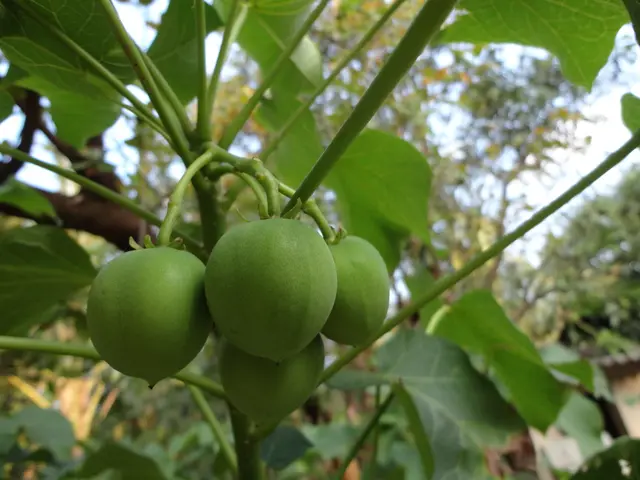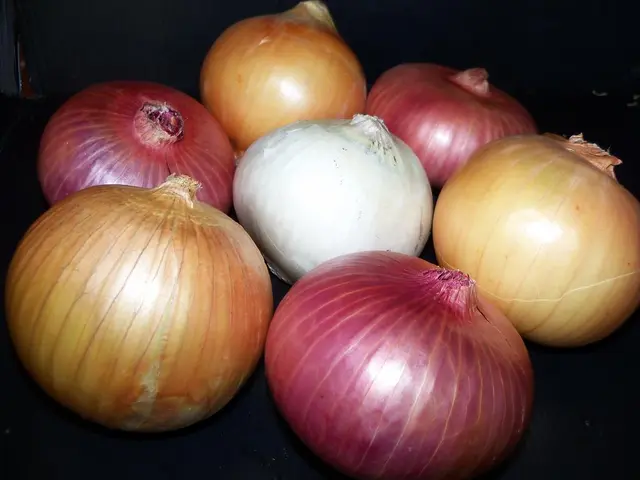Enhancing Tomato Fruit Set in Greenhouses: Top 6 Fertilizers for Optimal Fertilization
Growing A-maizing Tomatoes in a Greenhouse During Blooming: Picking the Best 6 Fertilizers for Maximum Fruit Production
Greenhouse tomatoes blooming? Super! But here's the trick, to develop strong fruit, not just flowers, your plants need some special nutrients. Properly fertilizing your tomatoes in a greenhouse during blooming results in a monster harvest! Let's dive in and discuss what you need and when.
Essential Ingredients for Blooming and Fruit Production:
- Phosphorus (P): A vital element for root development, blooming, and fruit production. A deficiency may lead to weak blooming.
- Potassium (K): Strengthens plants, improves pollen quality, boosts stress resistance (heat, humidity fluctuations), and encourages fruit production.
- Boron (B): A crucial component for pollination and fruit production. Boron deficiency often results in flower and fruit drop.
- Nitrogen (N): Cut back on nitrogen levels now. Excess nitrogen leads to excessive green growth at the expense of blooming and fruit production.
Top-notch Fertilizers for Feeding Blooming Greenhouse Tomatoes:
- Potassium Monophosphate (KH2PO4): A fantastic choice! Quickly absorbed source of phosphorus and potassium, with no fillers. Solution: 10-15g per 10L of water (root feeding).
- Superphosphate: A classic source of phosphorus and calcium. Dissolve ahead of time (1 tbsp in 1L hot water, let sit overnight, dilute to 10L).
- Potassium Sulfate (Potassium Sulfate): A great source of potassium. 15-20g per 10L of water. Often combined with superphosphate.
- Specialized Complexes: Look for fertilizers labeled "For Tomatoes and Peppers", "During Blooming and Fruiting" (NPK around 5-15-45, 8-15-30, etc.).
- Wood Ash: A natural source of potassium, phosphorus, calcium, and microelements. Brew: 1-2 cups of ash in 10L hot water, let sit overnight, strain. Water 0.5L per plant.
- Borax: Foliar feeding essential! Dissolve 1g (tip of a knife) in 1L hot water, cool, spray blooming clusters in the morning or evening. Note: Don't exceed the dose!
When and How to Feed in the Greenhouse:
- Huge Blooming Kick-off (1-2 clusters): First foliar feeding with phosphorus-potassium fertilizer (monophosphate potassium, superphosphate + potassium sulfate) or wood ash decoction. Water only on previously moistened soil!
- After 10-14 days: Repeat foliar feeding with the same composition.
- Boric Acid Spray: Apply 1-2 times during the blooming period, especially if the weather is cloudy or fruit production is poor.
Caveat: Follow dosages, use warm water (22-24°C) for solutions, and avoid feeding in hot weather. Watch your plants—their appearance is your best guide! Proper nutrition during blooming serves as your guarantee for a bountiful harvest of tasty greenhouse tomatoes!
Previously, we tackled five simple steps to save your tomatoes from late blight using milk serum.
Insights:
- Best Fertilizers for Tomato Blooming and Fruit Production
- Fertilizers with higher phosphorus and potassium ratios relative to nitrogen support fruit set, such as formulations like 5-10-10 or 2-3-6 (N-P-K) for late-season tomatoes or those in bloom[1][3][4].
- Balanced Fertilizers
- Optimal fertilizers balance phosphorus and potassium to prevent nutrient imbalances that might lead to blossom drop or poor fruiting[3].
- Tomato-specific Fertilizers
- Products like “Tomato Secret,” specifically formulated for tomato plants, are designed to encourage healthy and nutrient-rich fruit production[2].
In a Nutshell:
| Nutrient | Shining Moment in Fruit Production | Proper Strategy ||----------|----------------------------------------|---------------------------------------|| Nitrogen (N) | Promotes excessive vegetative growth; reduces fruit production | Use a lower nitrogen fertilizer during blooming || Phosphorus (P) | Encourages flower formation and root health | Boost phosphorus for improved blooms || Potassium (K) | Strengthens flowers and supports fruit development | Apply potassium-rich fertilizers |
Adding to your greenhouse lifestyle, proper fertilization of home-and-garden tomatoes during blooming is key for a bountiful harvest. Opt for phosphorus and potassium-rich fertilizers, such as Potassium Monophosphate, Superphosphate, Potassium Sulfate, and wood ash decoction, to ensure a strong fruit production. Gardening-wise, remember to cut back on nitrogen levels to avoid excessive green growth at the expense of blooming and fruit production.








